Different Types of Baby Carriers
Carrier Styles
Woven Wrap
Also referred to as: wraps, wovens, German-Style wraps
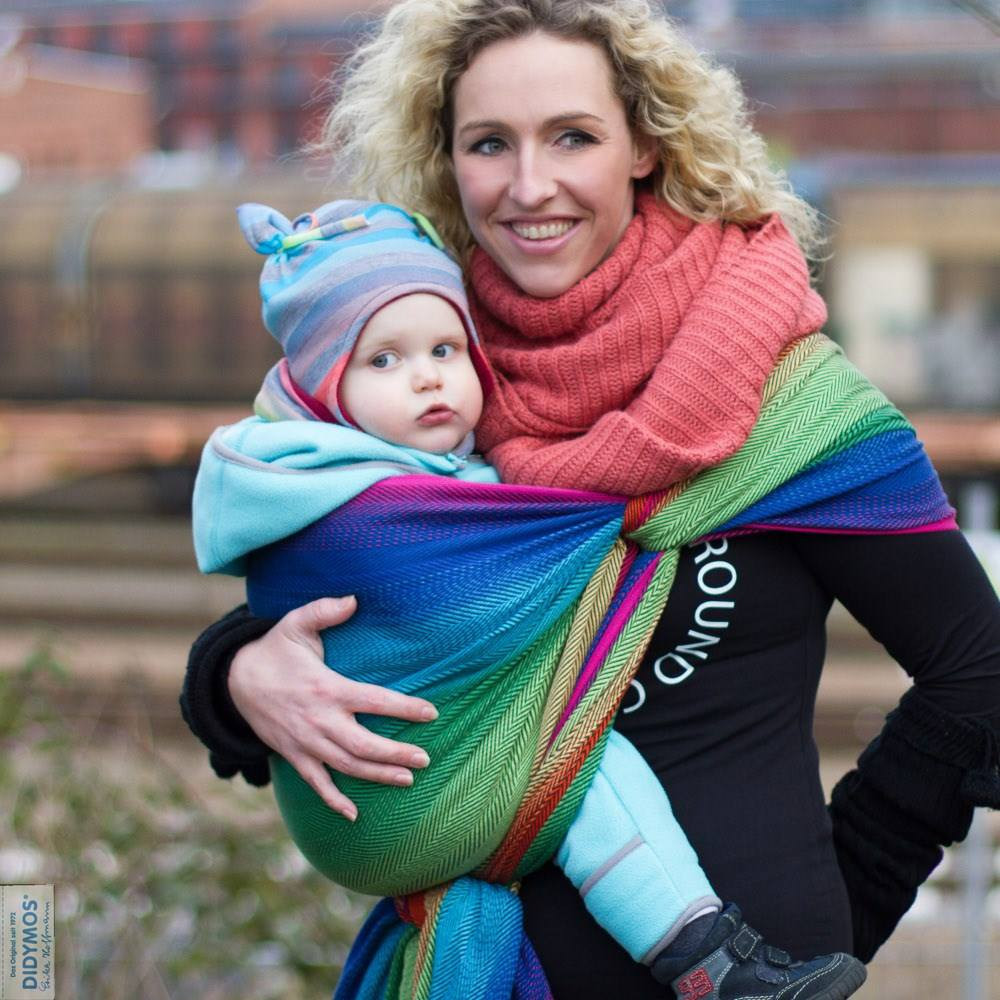 | 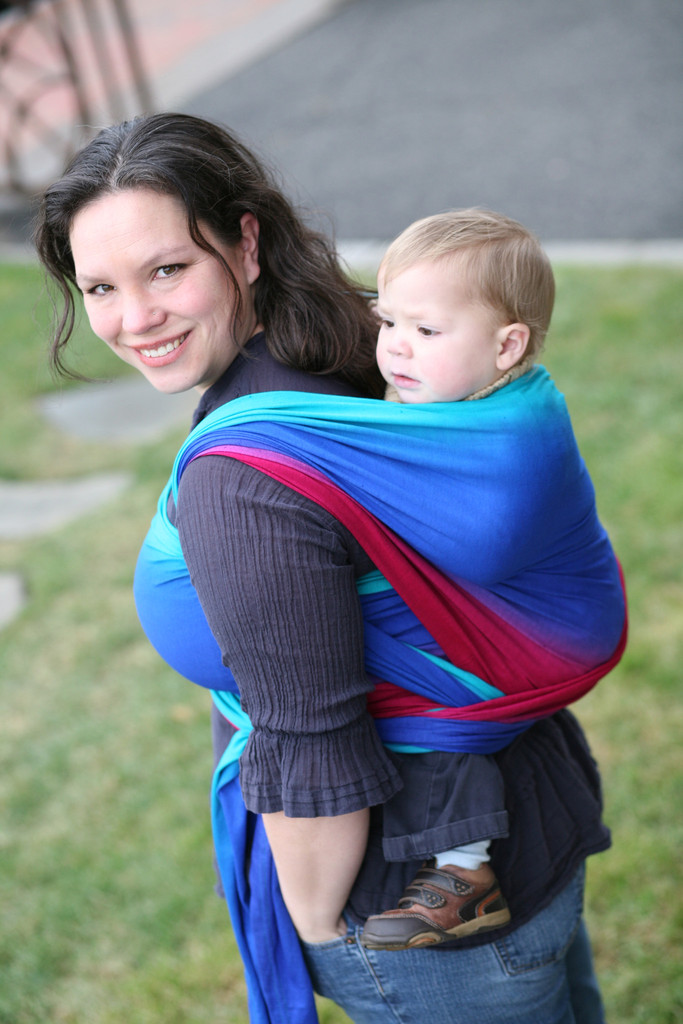 | 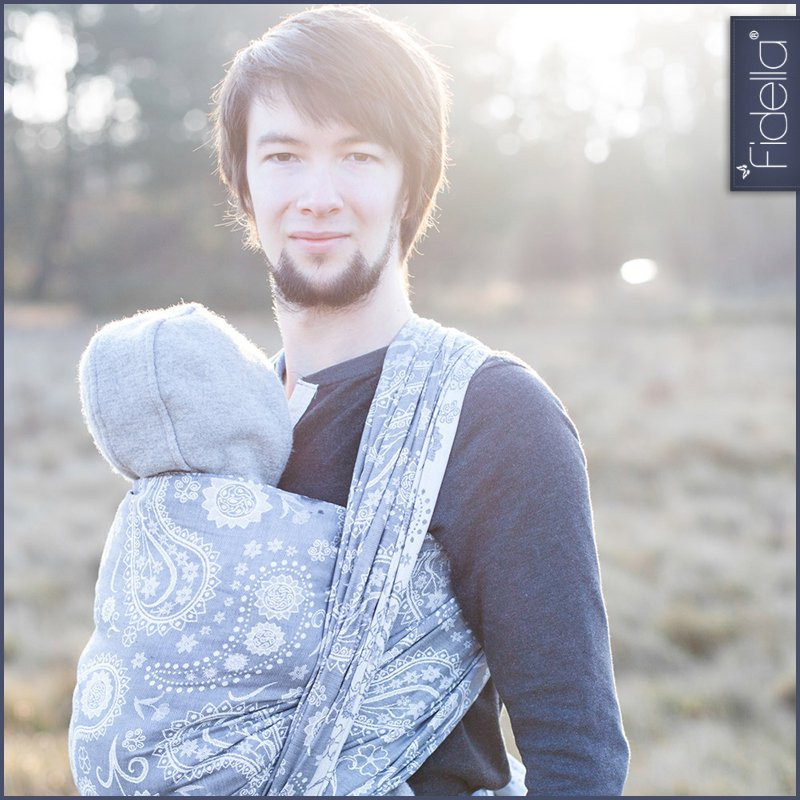 |
|
Didymos LISCA Rainbow wrap
Robins Hip Carry
Image sourced from 5mr.com |
Wrapsody Hybrid MEIRA stretch wrap
Double Hammock Back Carry
Image sourced from 5mr.com |
Fidella Persian Paisley Smoke wrap
Front Wrap Cross Carry
Image sourced from 5mr.com |
Description
A long, narrow parallelogram of woven (not stretchy) fabric. Ends may be blunt (making it a long rectangle) or
tapered. Used by wrapping around wearer and baby and usually secured with a double knot.
Dozens of different ways to wrap depending on personal preference, baby's age and wrap length.
Good For
- Front Carries: Good for all ages
- Hip Carries: Good for babies with strong truck control
- Back Carries: All ages (for experienced wrappers only; wearers should master front carries first.)
- Forward Facing: Good for babies with strong head control and decent truck control
Advantages
Incredibly versatile. Good for all ages newborn and up. No upper weight limit. No need to "upgrade" to bigger carriers for toddlers or preschoolers. Nearly all size wraps usable by nearly all size wearers. Good for front, back, hip or even forward facing. One of the few carriers that (with experience and care) can be safely used to back carry a newborn.
Disadvantages
Steep learning curve. Takes more time to get baby up.
Variations
- Handwoven: high quality, woven by hand. More "beauty marks," more expensive
- Machine woven: made to imitate a handwoven. Fewer "imperfections," more affordable
- Hybrid: stretches a little from rail to rail (no lengthwise stretch) giving it the snuggliness of a stretchy wrap but the versatility of a woven. (Popular brand: Wrapsody.)
- DIY/"Simple Piece of Cloth" - A woven wrap made from bolt fabric such as osnaburg or cotton duck or repurposed fabric like a tablecloth.
- Inoshi: A commercial wrap with a built-in tie waistbelt to make the seat unpoppable.
- Walter's Never Fail Wrap : A commerical wrap with built in leg holes to make the seat unpoppable.
- XOXO Carrier: A commercial carrier which is essentially two narrow cross passes of a wrap attached to a buckle waist band to make the seat unpoppable.
Sizing
Available in a wide
variety of sizes from a size 1 (2 meters long) up to a size 8 (5.6 meters long) or longer. All sizes are usable by nearly any size wearer or child. Wrap length simply determines what
kind of carries can by done. Most beginners start with their "base size" (whatever size is needed to do a Front Wrap Cross Carry; usually a size 5, 6 or 7 for most wearers) and carries are categorized based on what size is needed in relation to your base size. (For example: a ruck tied in front requires a wrap two sizes smaller than your base size, so it is referred to as a "base minus 2" carry. If you were a base 5, you could do this carry with a size 3 wrap. If you were a base 7, you would need a size 5 wrap to do the same carry.)
How to Use
How to Make
Return to Top
Stretchy Wrap
Also referred to as: Stretchy, brand names Moby, Boba, Solly, or K'Tan
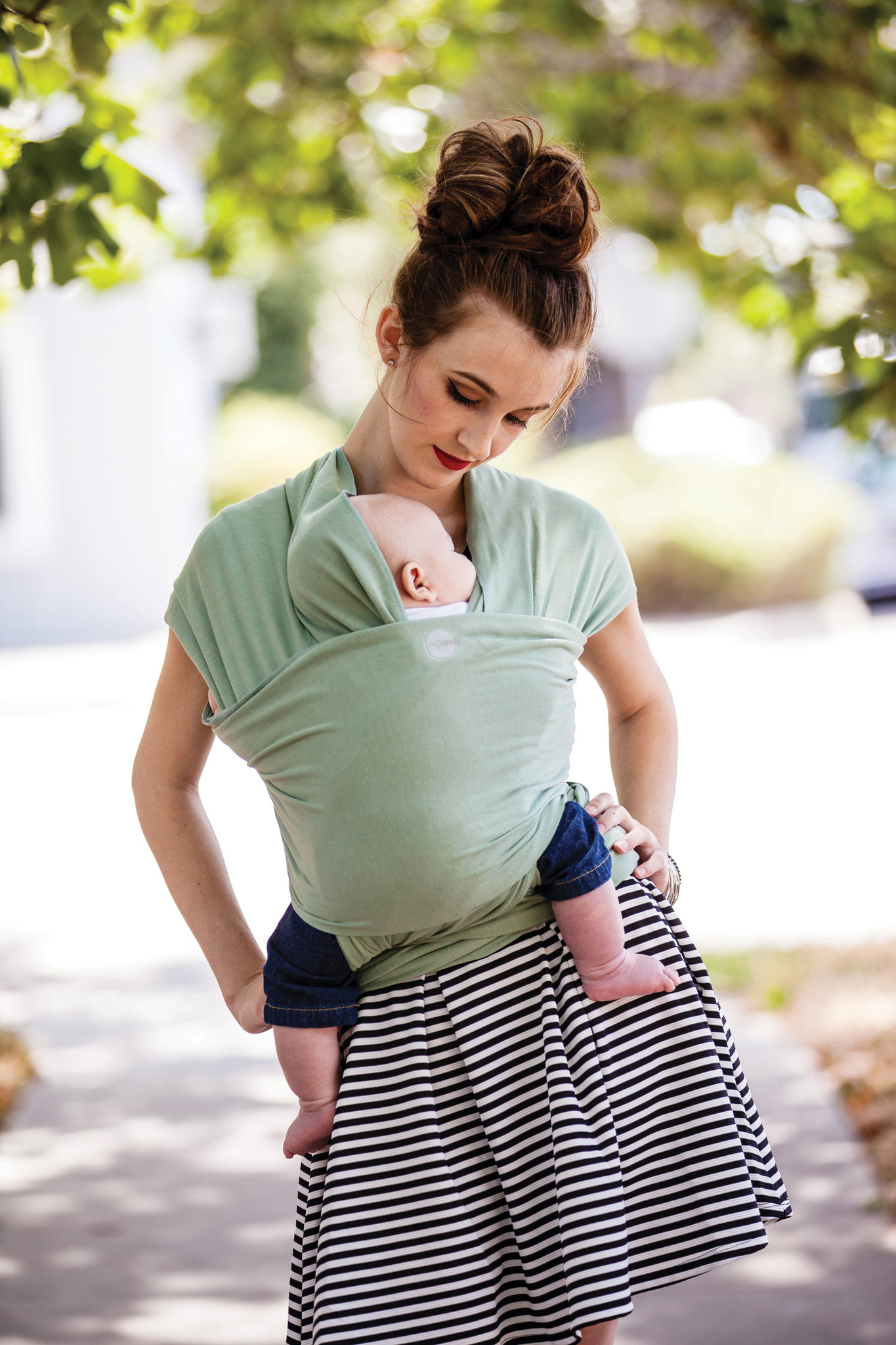 | 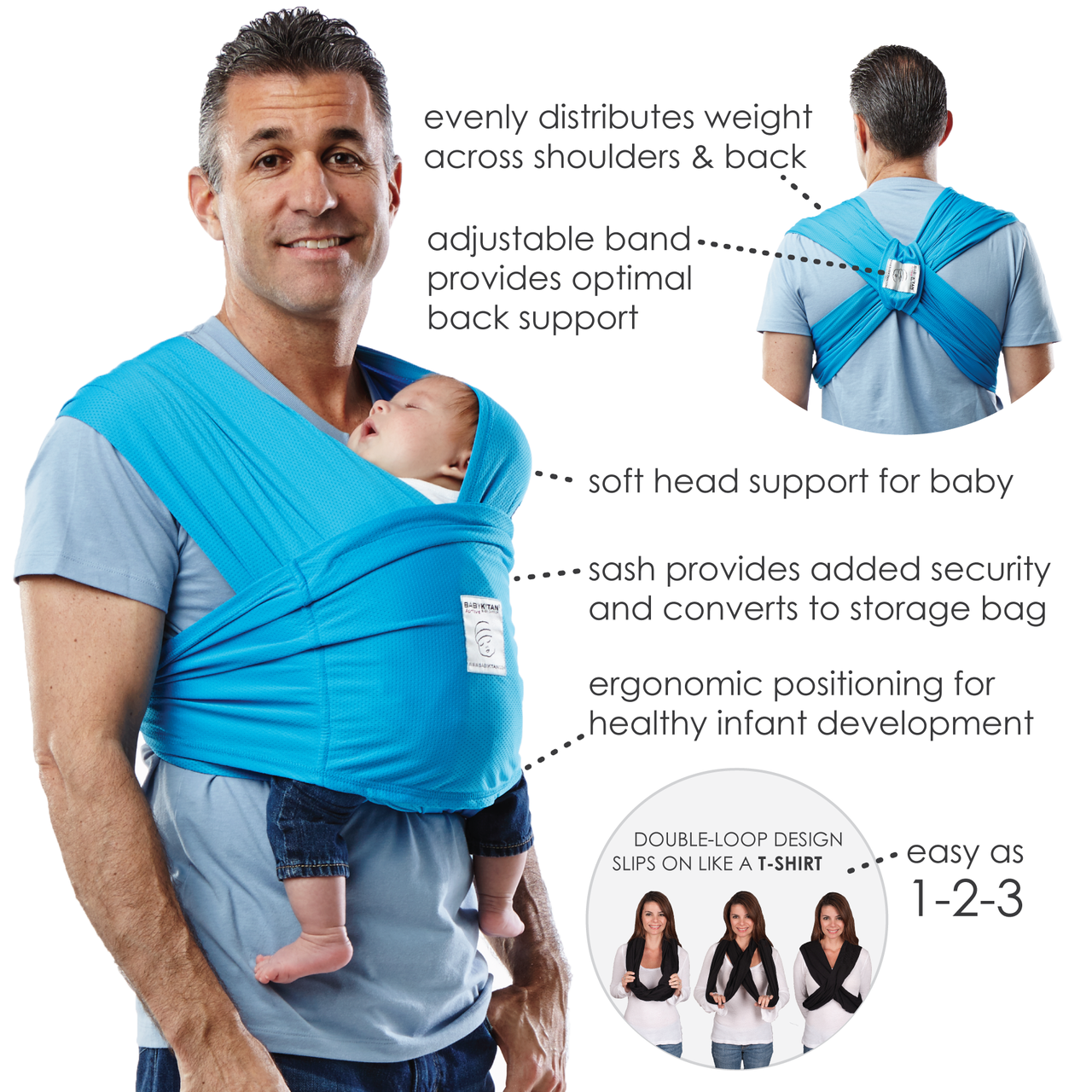 |
|
MOBY Wrap Classic
Basic Stretchy Wrap
Image sourced from MobyWrap.com |
Baby K'tan Original
Dual Pouch Style Carrier
Image sourced from Baby K'tan |
Description
A long, narrow parallelogram of stretchy fabric; usually similar to a jersey knit.
Good For
- Front Carries: Good from newborn and up with 3 reinforcing passes. Rated up to 35lbs, usually starts to get uncomfortable around 15lbs.
- Hip Carries: Good for babies with strong truck control with 3 reinforcing passes. Rated up to 35lbs, usually starts to get uncomfortable around 15lbs.
- Back Carries: Never Safe; Do Not Attempt
- Forward Facing: Debatable; typically considered fine for babies with strong trunk control
Advantages
Poppable and can be pre-tied (tie it once and then pop baby in and out as needed for diaper changes or to nurse.) One-size-fits-most. Good for tandeming with a larger child on your back since you can pre-tie the stretchy wrap, put larger child on your back, and then pop baby into the stretchy wrap without having to readjust.
Disadvantages
Tricky to learn how tight to pre-tie. Often only comfortable for the first few months of baby's life before baby is too heavy and it constantly sags (most moms stop liking them around 15lbs.) Must have three passes supporting baby, which means that they can be hot in summer. No way to safely back carry.
Variations
- "K'tan" or Huggaloops dual pouch carrier: instead of one long, continuous strip wrapped around three different times, it is instead two closed loops (each crossing the body diagonally) and one waist sash. Easier to put on, but must be carefully sized for the wearer.
Sizing
Regular stretchy wraps are nearly one-size-fits-all. Some companies like Moby do offer plus-sized lengths. Smaller wearers would simply wrap the extra tails around their waist an extra time before tying of.
K'tan-style loop carriers must be very carefully sized to the wearer as they have no way to adjust.
How to Use
How to Make
_
Return to Top_
Ring Sling
Also referred to as: RS
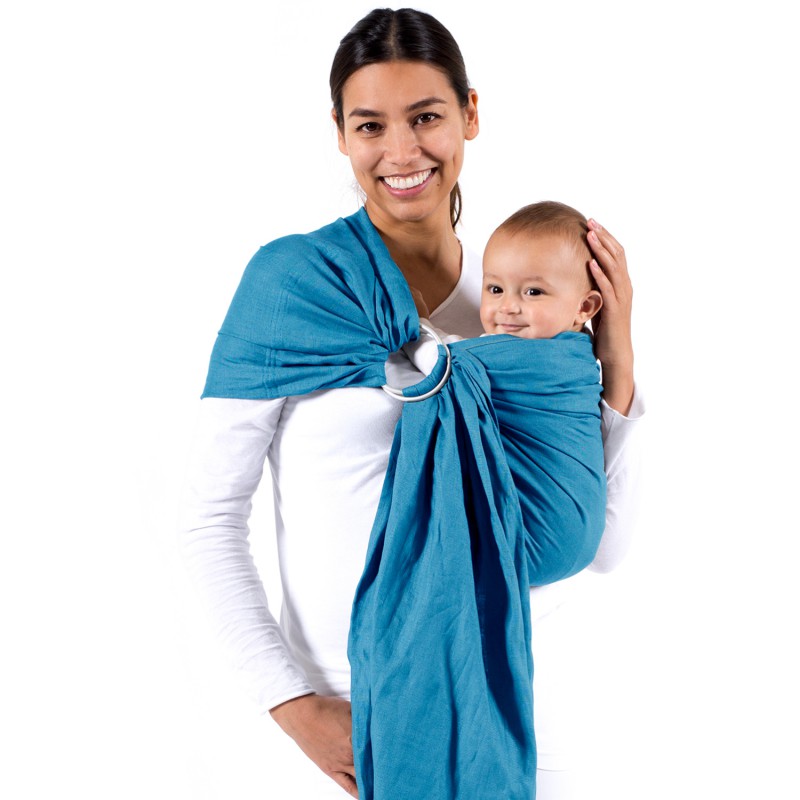 | 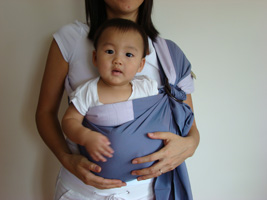 | 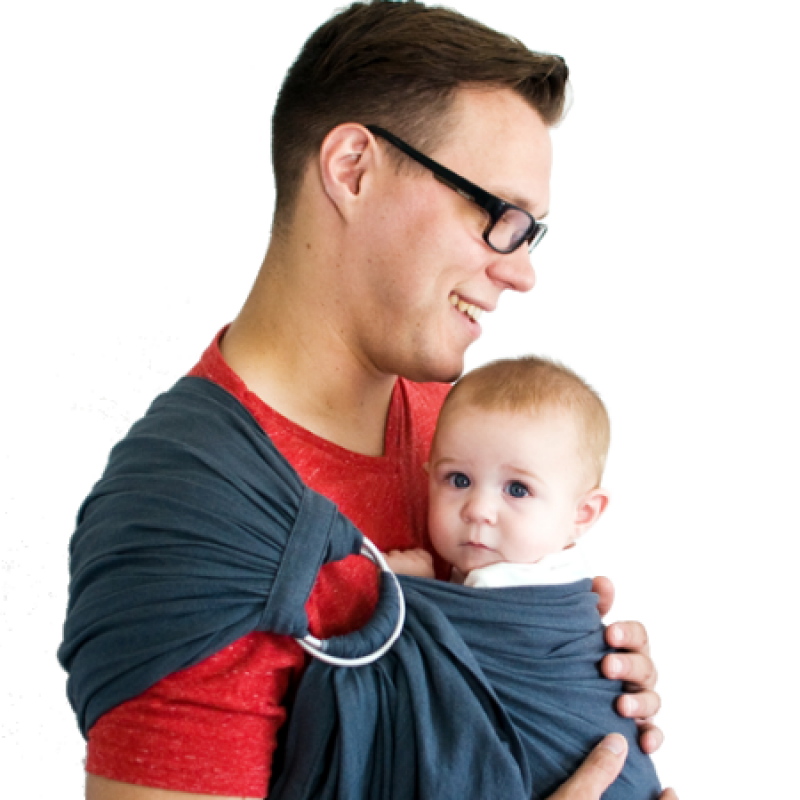 | 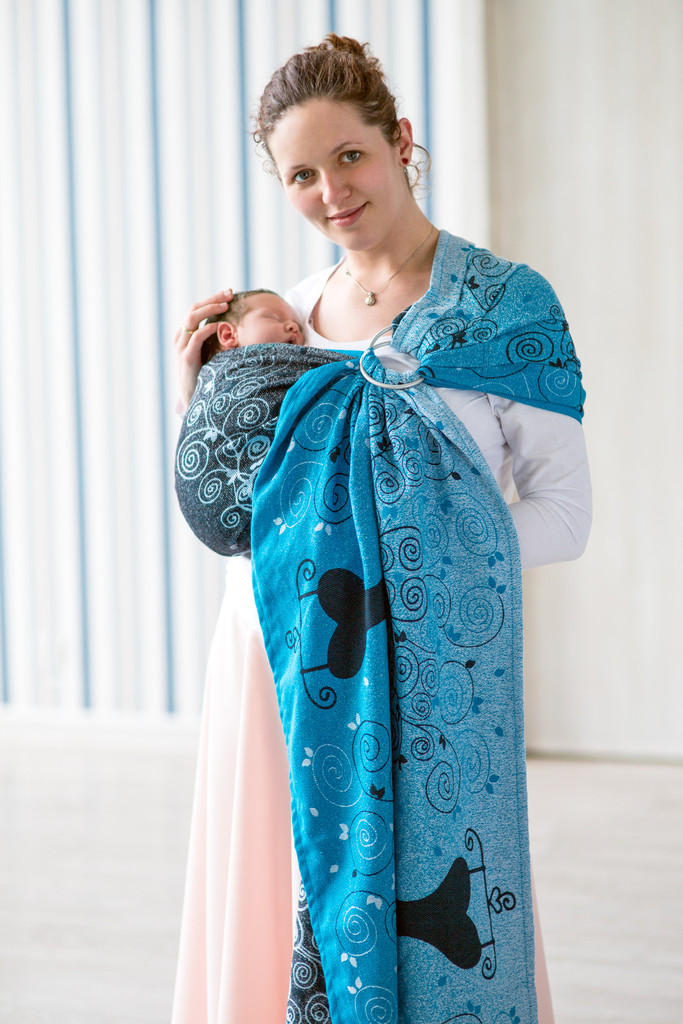 |
|
Beco Ring Sling - Gathered Shoulder
Image sourced from becobabycarrier.com |
Forward-facing "Kangaroo Carry"
Image sourced from babyslingsandcarriers.com |
Maya Comfortfit Sling
Image sourced from mayawrap.com |
Lenny Lamp Blue Princessa Wrap Conversion RS - Pleated Shoulder
Image sourced from 5mr.com |
Description
2-3 meters of woven (non-stretchy) fabric with two aluminum or nylon sling rings sewn onto one of the short ends. The fabric folded through the rings may be simply bunched (gathered), folded into neat pleats, or any combination of the two.
Good For
- Front Carries: Good for all ages
- Hip Carries: Good for babies with strong truck control
- Back Carries: Experienced wearers with trustworthy toddlers or older children only. Single-pass back carries are a risk to children who might lean backwards.
- Forward Facing: Good for babies with strong head control and decent truck control. Worn inside the "pouch" of the sling (instead of legs out) sitting cross-legged.
Advantages
Fairly easy to learn to use. Incredibly quick to put baby up or take them down. Easy to adjust one-handed. Incredibly newborn-friendly, but also good for toddlers who want up and down frequently. Easy to nurse in. Affordable. Easy to tandem two small babies on your front with two slings on opposite shoulders. Incredibly flexible sizing.
Disadvantages
One-shoulder carries can be less comfortable for larger babies or longer wearing. Not recommended for back carries. Not good for "seat poppers" or babies who tend to straighten their legs when worn.
Variations
- Pleated shoulder: the fabric sewn around the rings is first pleated to make the fabric narrower and neater and then sewn a few inches from the rings. Lays more neatly on the shoulder without getting bunched. Pleats may go straight across, be pleated from the center, box pleated, or any other combination.
- Gathered shoulder: the fabric sewn around the rings is simply bunched through the rings and then sewn straight across a few inches from the rings. Allows more "spread" to the fabric across the shoulder and therefore better weight distribution.
- Floating gathered shoulder: Same as gathered, except more fabric is pulled through so the stitching is 12"-16" away from the rings and sits behind the shoulder when worn. Allows for a double layer of fabric across the shoulder and the most spread.
- Hybrid/Eesti: any combination of the above; typically a few pleats along the outside of a gathered shoulder.
- Padded shoulder: padding is sewing into the shoulder and top rail of the sling for cushion.
- Closed-tail ring slings: the tail is a narrow strip that only allows you to loosen and tighten the sling as a whole; does not allow for strand by strand tightening of specific sections of the sling.
Sizing
Sizing simply effects the length of the sling, and therefore how much tail hangs through the rings after it is tightened. 12" of tail minimum is safe, and you want the tail at least 12" above the ground to avoid being a tripping hazard. That said, sizing is incredibly flexible. A 5'7", US size 10 woman can wear anywhere from an XXSmall to and XXLarge ring sling safely.
How to Use
How to Make
Return to Top
Pouch Sling
Also referred to as: pouch, brand name
SevenSlings, Hot Slings
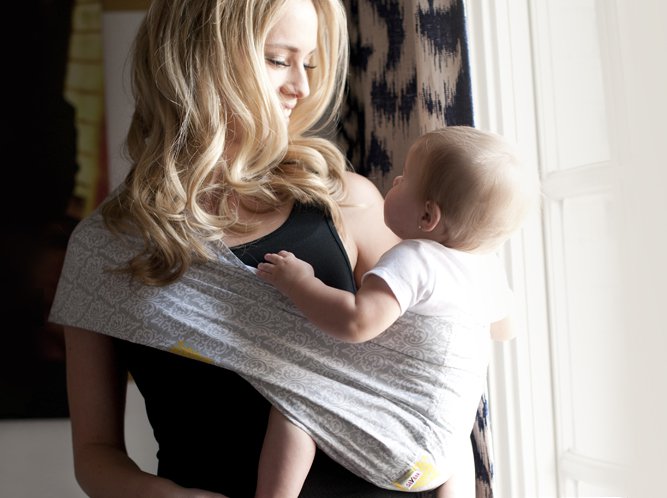 |
|
SevenSlings Hip Carry
Image sourced from sevenslings.com |
Description
A tube of woven (not-stretchy) fabric is sewn with a reinforcing seam. Worn diagonally like a sash, baby is then placed in the sling like a ring sling. Functions the same as a ring sling, except that there is no size adjustment.
Good For
- Front Carries: rated for newborns; typically preferred for babies with strong trunk control due to the lack of support offered unless sizing is absolutely perfect.
- Hip Carries: Good for babies with strong truck control
- Back Carries: Experienced wearers with trustworthy toddlers or older children only. Single-pass back carries are a risk to children who might lean backwards.
- Forward Facing: Good for babies with strong head control and decent truck control. Worn inside the "pouch" of the sling (instead of legs out) sitting cross-legged.
Advantages
Quick to put baby up and get baby out. Folds up incredibly small; can fit in a diaper bag or even a pants pocket for a back-up carrier. Very inexpensive.
Disadvantages
No ability to adjust size. Must be sized exactly right in order to provide proper support. One shoulder carries means that it can be less comfortable for longer wearing. Often advertised with newborns in a horizontal "cradle carry" which makes it very difficult to monitor breathing and keep baby from collapsing their chin to their chest. Not good for "seat poppers" or babies who tend to straighten their legs when worn.
Variations
- Some brands such as HotSlings do offer some minimal adjustment ability.
Sizing
Sizing is very dependent on both the wearer's and child's size and cannot be adjusted. Therefore, a pouch sling that fits a mom with her newborn may not fit the same mom when her baby is a toddler. If a mom and dad of different sizes wanted pouches to use for two different age children, they therefore may end up needing four different pouches to accomodate all 4 combinations of parent and child.
How to use
How to Make
Return to Top
Soft Structured Carrier
Also referred to as: SSC, Buckle Carrier, Full Buckle
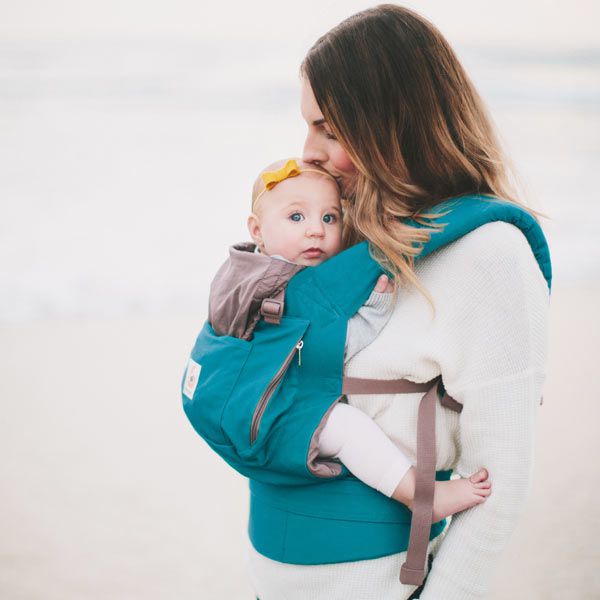 | 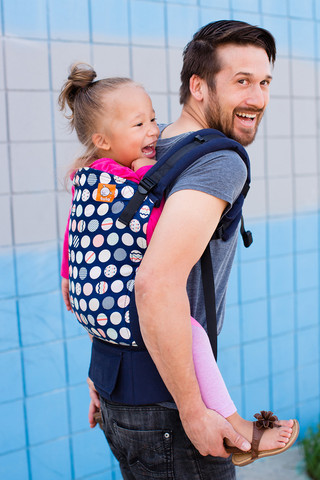 | 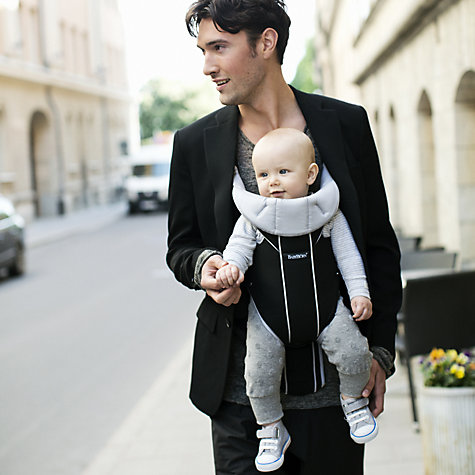 |
|
Ergobaby Original Baby Carrier Teal
Ergonomic Carrier, Front Carry
Image sourced from ergobaby.com |
Tula Toddler Carrier - Trendsetter Navy
Ergonomic Carrier, Back Carry
Image sourced from tulababycarriers.com |
BabyBjorn Miracle Carrier
Narrow Based Carrier, Forward Facing
Image sourced from johnlewis.com |
Description
A structured, usually shaped body panel attached to a waistband with a buckle closure and shoulder straps which attach to the body panel above the leg holes. Straps use buckles and ladder locks.
Good For
- Front Carries: depends on brand; typically good for all ages. Some brands require an infant insert for newborns.
- Hip Carries: depends on brand; for brands that allow it, good for babies with strong truck control
- Back Carries: depends on brand; for brands that allow it, good for babies who fit the carrier without inserts/modification and can sit independently.
- Forward Facing: Depends on brand; requires a carrier with either a narrow base or an ergonomic base that snaps in to a narrow setting. If so, good for babies with strong head and trunk control.
Advantages
The easiest style of carrier to learn to use. Very dad-friendly for fathers reluctant to learn wraps or slings. Usable by multiple sizes of wearers.
Disadvantages
Panel size is dependent on child's size. Therefore a parent who chooses to wear as their baby reaches toddlerhood or preschooler age may need to upgrade to a toddler-size or preschool-size carrier.
Structured, tailored design means that some brands may fit the wearer better than other brands. Preferable to try carriers on in person before purchasing.
Requires child to be fully sitting independently for extended periods of time before they can be used for a back carry.
Variations
- Narrow Based Carriers (NBCs) like BabyBjorn: has a narrower base that does not support baby's legs in an ergonomic "M" position. Not a safety risk for healthy babies, but may possibly exacerbate problems in babies predisposed to hip displasia.
- Unstructured, unpadded carriers like the Connecta or Sew Toot Voyager. Unpadded waist band is worn "apron style" (like a meh dai) and means that the carrier is less bulky and folds up smaller in a diaper bag.
- Hybrid carriers (Emeibaby, XOXO) combine aspects of a wrap with the ease of buckles.
Sizing
Body panel size is based on child's size. Body panel should be tall enough to reach at least up to baby's armpits but not so tall that baby's airway is obstructed. For new babies who still need neck support, panel should come up between the nape of their neck and the base of the ears. Some carriers recommend a brand-specific "infant insert" to provide core support for newborns, transitioning to the use of a "pillow" (or a rolled up receiving blanket) once the child fills out the body panel but is still a little too short for it. The width should be wide enough to support baby's legs from knee-pit to knee-pit (in an ergonomic carrier; narrow based carriers are not designed to do so) while still allowing the legs to swing freely at the knee. Babies whose legs are too short for the knees to swing freely off the sides of the panel should either be using an insert or (if the carrier allows) should be using the carrier snapped in to a narrow base setting. The straps on most soft structured carriers are one-size-fits-most, although some can be made with extra-length straps or can be sold with waist extenders.
How to Make
Return to Top
Meh Dai or Bei Dai
Pronounced "MEH dye" or "beh dai." Also referred to as: MT (
outdated), mei tai (
outdated)
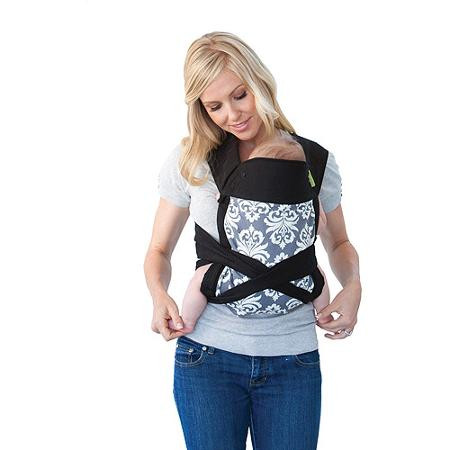 | 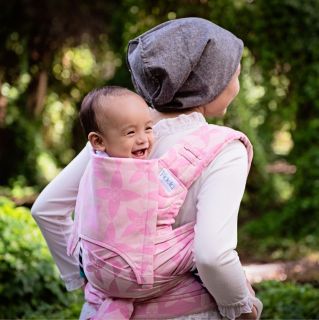 | 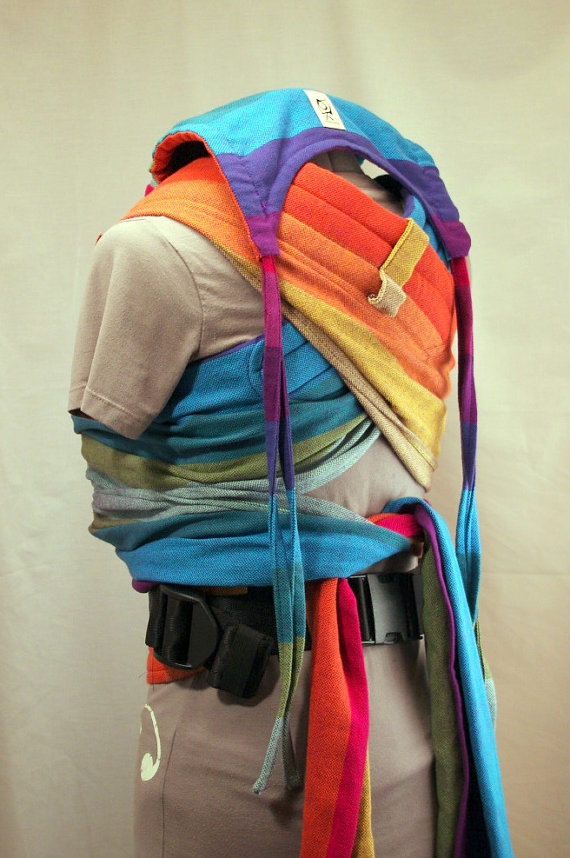 |
|
Infantino Sash
Padded Narrow Straps
Image sourced from infantino.com |
Fidella Wrap Strap Meh Dai Blossom Bubble Gum
Padded-to-wrap straps
Image sourced from fidella.org |
Half Buckle Wrap Conversion Meh Dai with hood
Image sourced from Etsy shop Obimama |
Description
A rectangular body panel with two long shoulder straps coming out of the top corners diagonally and two shorter waist straps coming out of the bottom corners horizontally. The carrier is tied around the waist hanging down, "wrong-side" out like an apron, and then pulled up over baby. The shoulder straps go over the shoulders, under the arms, and either tie under baby's bum or cross over baby, under baby's legs and then tie.
Good For
- Front Carries: Good for all ages
- Hip Carries: Good for babies with strong truck control
- Back Carries: All ages (for experienced wearers only)
- Forward Facing: Good for babies with strong head control and decent truck control; usually requires the carrier to be modified/cinched narrower.
Advantages
Incredibly easy to learn to use. Flexible sizing can fit multiple parents. Offers wrap-like support with the ease of a buckle carrier. Ability (with experience and care to monitor breathing) to back carry newborns safely. Waist-strap and two shoulder straps offer good weight distribution for long wearing. Easy to adjust panel size (by rolling the waistband or cinching the bottom) to fit a newborn.
Disadvantages
Panel size is dependent on child's size. Therefore a parent who chooses to wear as their baby reaches toddlerhood or preschooler age may need to upgrade to a toddler-size or preschool-size carrier.
Variations
- Wrap strap: Straps are wide (10"-15") and flat like a woven wrap.
- Narrow or "Tube" strap: Straps are sewn into a flattened tube (narrower, usually around 4", and double layered.)
- Padded straps: Section of the shoulder straps closest to the body panel include padding, usually either fleece or open cell foam.
- Half-buckle: Waist straps include a buckle closure instead of a tie closure.
- Ring-waist: One waist strap is replaced by double sling rings, which the other waist strap is threaded through like a D-ring belt.
Sizing
Body panel size is based on child's size. Body panel should be tall enough to reach at least up to baby's armpits but not so tall that baby's airway is obstructed. (The waist band can be "rolled" an extra time to shorten a too-tall panel.) The width should be wide enough to support baby's legs from knee-pit to knee-pit, while still allowing the legs to swing freely at the knee. (The body panel can be cinched with a ribbon or hair tie to make it narrower for smaller babies.) The strap length is determined by the wearer's size. Most mei tai strap lengths are considered one-size-fits-most.
How to Use
How to Make
Return to Top
Onbuhimo (Traditional)
Also referred to as: Onbu (
outdated, listed for clarification only)
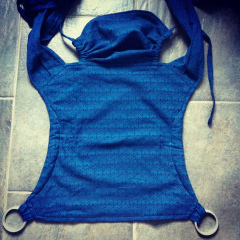 |
|
Traditional Onbuhimo with rings
Image sourced from cherryberrybaby.co.uk |
Description
A rectangular body panel with two long shoulder straps coming out of the top corners diagonally and two short fabric loops or attached sling rings coming out of the bottom corners horizontally. Baby is put on to the wearer's back high with arms out. The shoulder straps come down, are threaded through the loops/rings and then tied off (typically tied tibetan by crossing the straps back under the opposite shoulder strap and then tying the tails in a double knot.)
Good For
- Front Carries: Not designed for front carries. Possible with long enough straps to cross in the back, add support with reinforcing passes and close off the open sides.
- Hip Carries: Not designed for hip carries.
- Back Carries: Babies who can sit independently only.
- Forward Facing: Not designed for forward facing.
Advantages
Quick to put on and an unpoppable seat makes it easier to wear wiggly or difficult toddlers who may not have the patience for wrapping. Lack of waist belt is great for anybody who doesn't want the pressure on their waist, including (but not limited to) expectant mothers.
Disadvantages
More limited than other carriers, since onbuhimos are really best for older, independently sitting babies and only designed for back carries. Panel size is dependent on child's size. Therefore a parent who chooses to wear as their baby reaches toddlerhood or preschooler age may need to upgrade to a toddler-size or preschool-size carrier.
Variations
- Fabric loops: shoulder straps are threaded through simple fabric loops at the bottom corners
- Ring loops: a small sling ring is attached with a small fabric loop at each of the bottom corners.
- X-onbuhimo or Blanketless Onbuhimo: Functions the same as a traditional onbuhimo, but instead of separate straps and body panel, it is constructed in an "X" shape with two narrow slings.
Sizing
Body panel size is based on child's size. Baby needs to be able to fit in the carrier arms-out, but the panel must not be so low that baby can lean backwards. The width should be wide enough to support baby's legs from knee-pit to knee-pit, while still allowing the legs to swing freely at the knee. The strap length is determined by the wearer's size.
How to Use
How to Make
Return to Top
Reverse Onbuhimo
Also referred to as: Reverse Onbu, Ruck-Bu (
both terms outdated, listed only for clarification only)
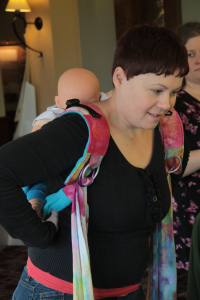 |
|
Reverse Onbuhimo
Image sourced from cherryberrybaby.co.uk |
Description
A rectangular body panel with two shorter shoulder straps coming out of the top corners diagonally (usually padded) with double sling rings on each, and two long wrap straps coming out of the bottom corners horizontally. The bottom straps are pre-threaded through the double sling rings on the shoulder straps like one would a ring sling. Baby is put on to the wearer's back high with arms out, and the tails of the straps are pulled to tighten the shoulder straps. Tying off is optional (since the double sling rings lock the straps in place) but longer straps allows for reverse reinforcing passes for more support and/or a tibetan tie-off.
Good For
- Front Carries: Not designed for front carries. Possible with long enough straps to cross in the back, add support with reinforcing passes and close off the open sides, but incredibly awkward to cross and thread the straps behind your back.
- Hip Carries: Not designed for hip carries.
- Back Carries: Babies who can sit independently only.
- Forward Facing: Not designed for forward facing.
Advantages
Quick to put on and an unpoppable seat makes it easier to wear wiggly or difficult toddlers who may not have the patience for wrapping. Lack of waist belt is great for anybody who doesn't want the pressure on their waist, including (but not limited to) expectant mothers. Lack of waist belt and tie offs makes them great for tandem-wearing, since there is nothing to interfere with the front baby.
Disadvantages
More limited than other carriers, since onbuhimos are really best for older, independently sitting babies and only designed for back carries. Panel size is dependent on child's size. Therefore a parent who chooses to wear as their baby reaches toddlerhood or preschooler age may need to upgrade to a toddler-size or preschool-size carrier. Puts all the weight high and on the shoulders, which can be difficult for some wearers.
Variations
- Padded Shoulder: rings are attached on top of a padded strap so the rings do not dig into the wearer's shoulder
- Reverse X-onbuhimo or Reverse Blanketless Onbuhimo: Functions the same as a regular reverse onbuhimo, but instead of separate straps and body panel, it is constructed in an "X" shape with two narrow slings.
Sizing
Body panel size is based on child's size. Baby needs to be able to fit in the carrier arms-out, but the panel must not be so low that baby can lean backwards. The width should be wide enough to support baby's legs from knee-pit to knee-pit, while still allowing the legs to swing freely at the knee. The strap length is flexible, but determined by wearer's size and whether or not the wearer wants to be able to do reinforcing passes or tibetan tie-offs.
How to Use
How to Make
Return to Top
Buckle Onbuhimo
Also referred to as: buckle-bu (
outdated term; listed only for clarification)
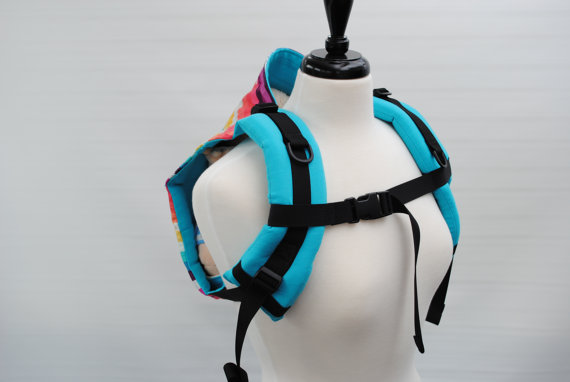 |
Sew Toot Barefoot Buckle Onbuhimo
Image sourced from Etsy shop Sew Toot |
Description
A rectangular body panel with padded backpack-like straps and webbing attaching each top corner to the bottom corner on the same side. A chest clip attaches the two shoulder straps together.
Good For
- Front Carries: Not designed for front carries. Possible with babies with decent trunk control if the carrier allows the straps to cross in the back.
- Hip Carries: Not designed for hip carries.
- Back Carries: Babies who can sit independently only.
- Forward Facing: Not designed for forward facing.
Advantages
Quick to put on and an unpoppable seat makes it easier to wear wiggly or difficult toddlers who may not have the patience for wrapping. Lack of waist belt is great for anybody who doesn't want the pressure on their waist, including (but not limited to) expectant mothers. Lack of waist belt and tie offs makes them great for tandem-wearing, since there is nothing to interfere with the front baby.
Disadvantages
More limited than other carriers, since onbuhimos are really best for older, independently sitting babies and only designed for back carries. Panel size is dependent on child's size. Therefore a parent who chooses to wear as their baby reaches toddlerhood or preschooler age may need to upgrade to a toddler-size or preschool-size carrier. Puts all the weight high and on the shoulders, which can be difficult for some wearers.
Variations
- Ladder lock straps: Instead of buckling closed, a buckle onbuhimo with ladder lock closure is permanently "closed" and simply tightens or loosens with ladder locks like a back pack.
Sizing
Body panel size is based on child's size. Baby needs to be able to fit in the carrier arms-out, but the panel must not be so low that baby can lean backwards. The width should be wide enough to support baby's legs from knee-pit to knee-pit, while still allowing the legs to swing freely at the knee. The shoulder strap lengths are flexible, but determined by wearer's size.
How to Use
How to Make
Return to Top
Podaegi
Pronounced "poh-DEH-gee" (hard G.) Also referred to as: pod (
outdated term, listed only for clarification)
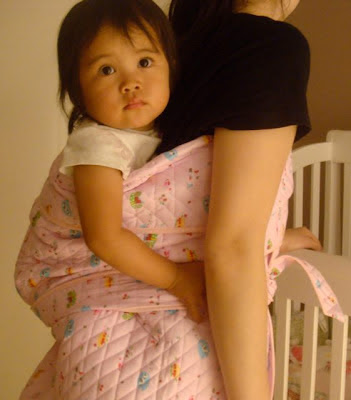 |
|
Traditional wide-blanket podaegi
Back Carry
Image sourced from littleseouls.blongspot.com |
Description
A wide rectangular "blanket" is attached to a long, continous strap coming out horizontally from the top corners of the "blanket." The blanket wraps around both the wearer and the wearee and the straps then cross under baby's bum to secure them.
Good For
- Front Carries: Good for all ages
- Hip Carries: Good for babies with strong trunk control.
- Back Carries: All ages (for experienced wearers only)
- Forward Facing: Not designed for forward facing.
Advantages
Simple, traditional construction. Less "material" to deal with than a meh dai or a woven wrap.
Disadvantages
Less common carrier makes documentation on usage harder to find. Safety standards have not been created for podaegis, so no commercial podaegis exist that pass current carrier safety testing.
Variations
- Traditional/Wide-blanket: the "blanket" is wide enough to wrap around both baby and wearer. Baby is wrapped with straps going over both legs and under their bum with legs inside the blanket. Blanket is sometimes quilted.
- Narrow-blanket: the "blanket" is sized more similarly to a mei tai, allowing baby to be worn with a more wrap-like reinforcement with legs out and each reinforcing strap going over the first leg and under the second. Modeled after the traditional Hmong Nyia. The term "narrow blanket podaegi," due to its inaccuracy, has fallen out of favor, and it is preferred to use the more accurate term "Nyia."
Sizing
One size fits most. Total combined strap length should be somewhere between the wearer's "base size" wrap (the length needed in a wrap to do front wrap cross carry) and a base-2, so plus size wearers may occasionally need slightly longer straps.
How to Use
How to Make
Return to Top
Nyia
Pronounced "nee-AH" Also referred to as: Hmong baby carrier, narrow-blanket podaegi (
outdated term, listed only for clarification)
 |
Modern Nyia with angled straps
Image sourced from southlondonslings.co.uk
|
Description
A narrow and long rectangular "blanket" is attached to a long, continous strap coming out horizontally from the top corners of the "blanket." Some have two angled straps coming out of the top corners more like a meh dai, instead.
Good For
- Front Carries: Good for all ages
- Hip Carries: Good for babies with strong trunk control.
- Back Carries: All ages (for experienced wearers only)
- Forward Facing: Not designed for forward facing.
Advantages
Simple, traditional construction. Less "material" to deal with than a meh dai or a woven wrap. Size is nearly universal for all wearers and wearees.
Disadvantages
Less common carrier makes documentation on usage harder to find. Safety standards have not been created for nyia, so no commercial nyia exist that pass current carrier safety testing.
Variations
- Straight straps: Top straps are horizontal and sometimes one continuous strap going through the top of the blanket.
- Angled straps: Top straps are two independent straps anchored at an angle to the blanket more like the construction of a modern meh dai.
Sizing
One size fits most. Total combined strap length should be somewhere between the wearer's "base size" wrap (the length needed in a wrap to do front wrap cross carry) and a base-2, so plus size wearers may occasionally need slightly longer straps.
How to Use
How to Make
_
Return to Top_
--
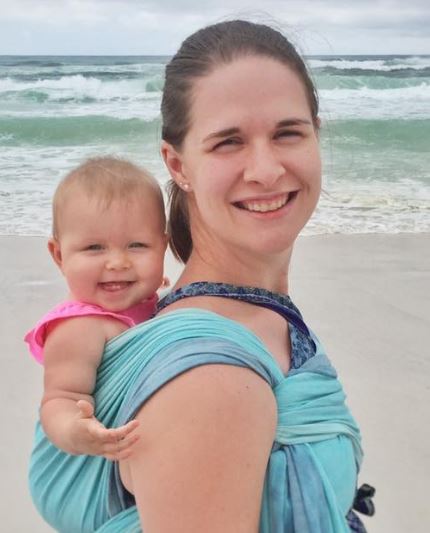 Alyssa Leonard - 2017-05-13
Alyssa Leonard - 2017-05-13























